
by Lisa Richman | Jun 29, 2021 | Travel Croatia
Enjoy a piece of history in Smiljan, a lovely village in the mountainous region of Lika, Croatia. Smiljan is known best for being the birthplace of Nikola Tesla, born on July 10, 1856.
In honor of the 150th anniversary celebration of this luminous pioneer and inventor, Croatian officials established a Tesla memorial complex, including a museum, within his restored childhood home.
Tesla’s residence, together with the Orthodox church of St. Peter and Paul (built in 1765), and the surrounding area, is complete with exhibits displaying Tesla’s inventions, and a museum detailing his life.
During the Croatian War of Independence, several of the buildings were severely damaged by fire. Croatian authorities restored them, reopening them in a 2006 ceremony, replete with the most prominent Serbian and Croatian dignitaries.
For those of you who will be traveling on “Croatia and Beyond!”, I look forward to exporting you on this memorial “add on excursion.

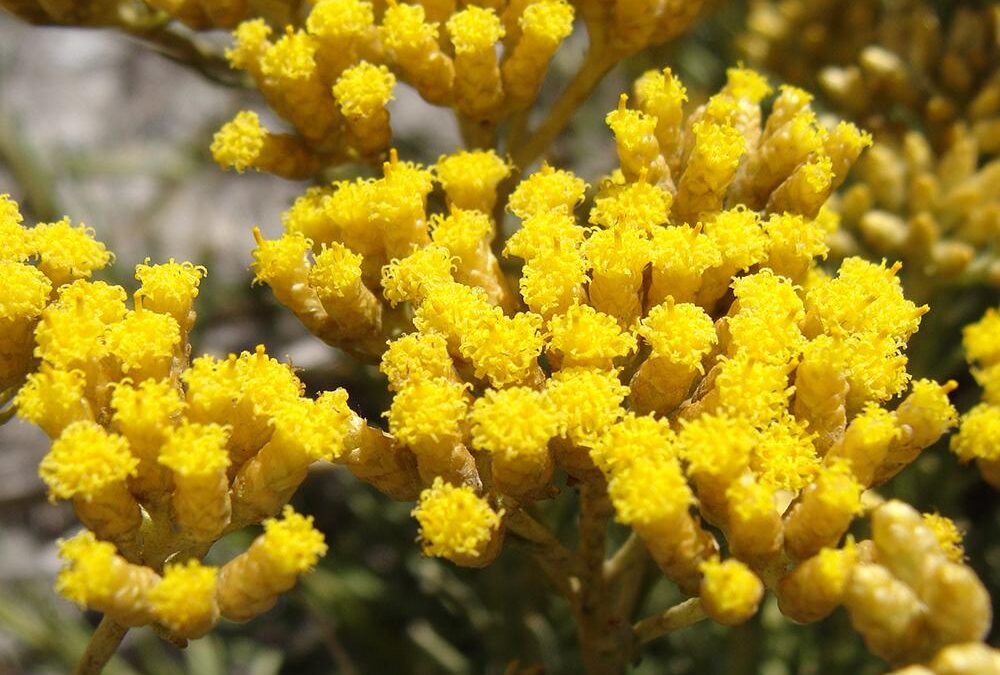
by Nada Cory | Aug 6, 2020 | Product Facts, Travel Croatia
Medjugorje, Bosnia, is situated in the valley of a mountainous rocky terrain where little grows. Thus, passion and dedication are necessary to bring forth anything edible and useful to its people. Surprisingly and beneficial for us all, there are numerous wild medicinal plants that grow abundantly, surviving this ruggedness. One in particular is the beloved flowering Helichrysum plant, or Immortelle as it is called in Latin (meaning immortal or everlasting). Thriving and blooming during the year, June and November are the two months when the hills are full of their aroma, and blanketed with rich yellow flowers. The natural evolution of time, has encouraged this lauded plant to sprout deep roots under the rocks, seeking the water that remains there, overcoming obstacles and its environment.
The people of Medjugorje have long understood the importance of Immortelle, planting it in abundance, and overseeing it through difficult times, its harvest and distillation process. (Fact: it takes 4.4 pounds of blossoms to make 5 ml of essential oil!) With today’s technology, man has eased the arduous course, by crushing the rocks, turning them into a soil that is pure, mineral rich, organic, and perfect for making this variety of Immortelle superlative.
Currently, we have recognized the benefits of Helichrysum in a variety of ways; the stems, leaves, dried flowers, and oil are utilized in therapeutic approaches. Its properties reportedly help promote healing, fight infection, and reduce inflammation. Other evidence shows that is may reduce allergy symptoms and heal contact dermatitis, and as an antimicrobial, fights colds and coughs. Wound healing and a wide range of digestive issues are also cited as benefits from its oil, not to mention improved mental clarity and circulation. The list continues, and happily, the region has taken to cultivating this most special plant, and Nadona International has made it possible for the public to experience its value firsthand, with products that have been created with intention.
It is no wonder that Helichyrsum has many benefits, for surrounding this wonderous plant, is the story that substantiates its miracle. It is recounted, in June 1981, six local children unexpectedly started having visualizations. They would see and speak to Mother Mary, the beloved patron of the Croatian people and beyond. Their encounter was witnessed by many, yet none could hear their conversations, as it seemed they were suspended in a time capsule unto themselves. During those moments of sacred revelations, they received messages and instructions on how to pray with intent and heart: The main message to be shared with to all the people – Pray for Peace!
Locally and internationally, the news spread quickly, people flocked to this small humble and relatively poor town of Medjugorje, seeking answers to their prayers. The effects of these apparitions changed the lives of the resident population, observing what Mary had imparted to the children. Locals shared what they could do for the ever-increasing numbers of “pilgrims”, even if it was simply water and bread. They gave from the heart and embraced all that came.
Today more than ever, the ancient qualities of the Helichrysum plant have been rediscovered and treasured again. These plants, which seem to be imbued with the characteristics of healing, are much sought after, making them a blessing to us all. The time in which we live, could not be more in need of natural remedies to boost our own immune system, and heal our bodies and our hearts. Nadona International encourages you to utilize our quality proprietary Immortelle Oil™, and to look forward to the launch of our Immorlyt™ Facial System.
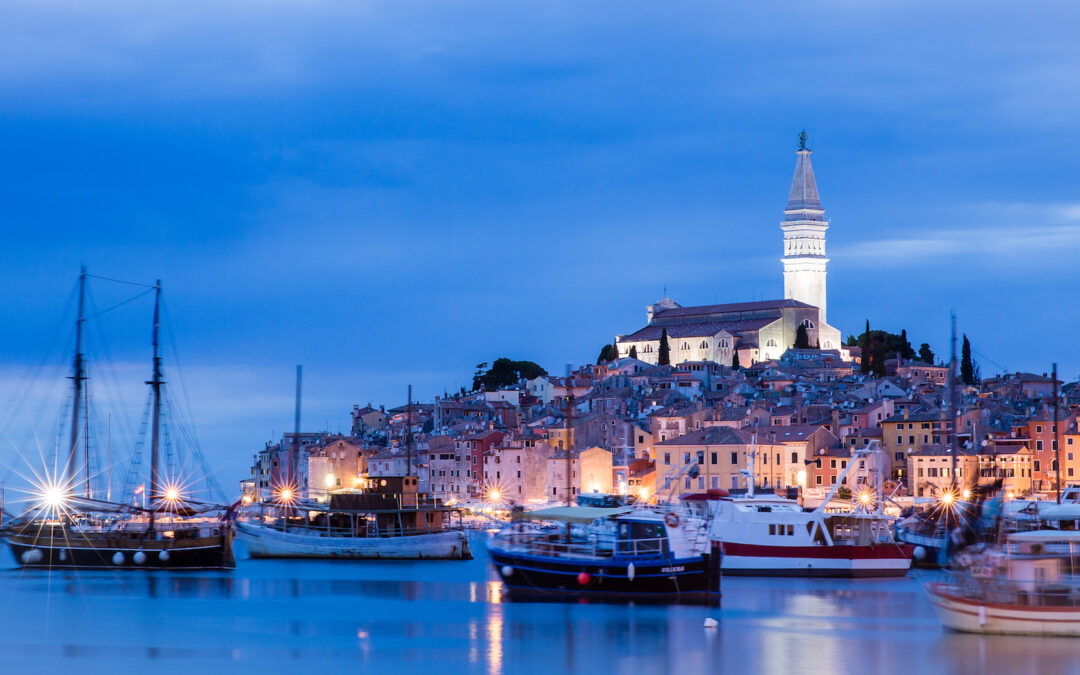
by Nada Cory | Jul 2, 2020 | Travel Croatia
As a native of Croatia, I have always been blessed to live in such a paradise; the array of topography, flora, fauna, tastes and sounds, never gets old. Sometimes you just need a little well-deserved getaway for inspiration and to sooth your soul; what better way than to hop in your car, travel a few hours, and visit Rovinj. Join me!
There is so much to do and see in Rovinj, so let us make this seaside city our home base for our daily adventures. Rovinj, whose historic core, (old town), is mostly Venetian, was built with pale limestone that glows in the sun. Houses hug one another all the way down to the seafront, and cobblestone streets lead to the hilltop church of St. Euphemia, dominating the skyline. City center is quaint, full of restaurants and cafes, and we will always find time for a delicious nibble, to watch this ancient town go about its day.
The Cathedral of St. Euphemia, recognizable near and afar, sports a baroque campanile, and closely resembles St. Mark’s in Venice. It’s no surprise that the 17th-century St. Euphemia was built by the Venetians, who were in control of Rovinj throughout this period. To get the lie of the land you can make your way up the campanile, which is 200 feet high and offers views of the Alps to the north on a clear day. The church’s interior boasts some sumptuous designs, including a marble altar with a 15th-century statue of the saint, before a sarcophagus containing Euphemia’s relics.
Rovinj’s Heritage Museum was founded by a group of Rovinj’s artists in the 1950s as a way of bringing together the area’s cultural wealth, and displaying the work of local painters and sculptors. These is a gallery space here with some 1500 pieces of contemporary art, next to exhibit rooms with important artefacts relating to the various cultures that settled in Rovinj, and the city’s rich maritime history. The museum’s grand home is a big part of its appeal; it’s a four-story baroque palace built by the Counts of Califfi in the 1600s.
Leading to Grisia Street away from the main square is the imposing Balbi’s Arch from the late 1670s, named after Daniel Balbi, who was the mayor at the time. The arch replaced an old town gate and bears the classic Venetian hallmark of the Lion of St. Mark. Curiously there are also two stone heads, one on either side of the arch; on one you can make out the head of a bearded Venetian, and on the other there’s a Turk, wearing a turban.
We are working up an appetite after exploring this beautiful town, and drawing in the aromas wafting through the town. For our culinary focused travelers, let us experience a genuine taste of Istria, and dine on fuzi pasta, which is the local pasta variety. These are small rolled sheets (relatively similar to penne) served with a veal sauce made with wine and tomatoes. In many restaurants, it is custom to grate white truffle on top. Truffles grow in abundance in central Istria’s damp oak forests, and in fact, the all-time largest in the world was discovered outside of Buje in 1999, weighing almost three pounds! Istria’s Italian connection is evident from the amount of traditional oven pizzerias in towns like Rovinj; why not maximize the best of everything and order their famous seafood pizza!
Visit our blog page, for some of our other adventures in this profoundly beautiful part of Croatia. Each day we will be visiting Istria’s magnificent sites, such as the beaches and ports, Pula and its renowned amphitheater, Monkodonja’s archaeological site, the medieval town of Dvigrad, Lim Fjords, and Brijuni National Safari Park, to name a few. Food, friends and fun await you!
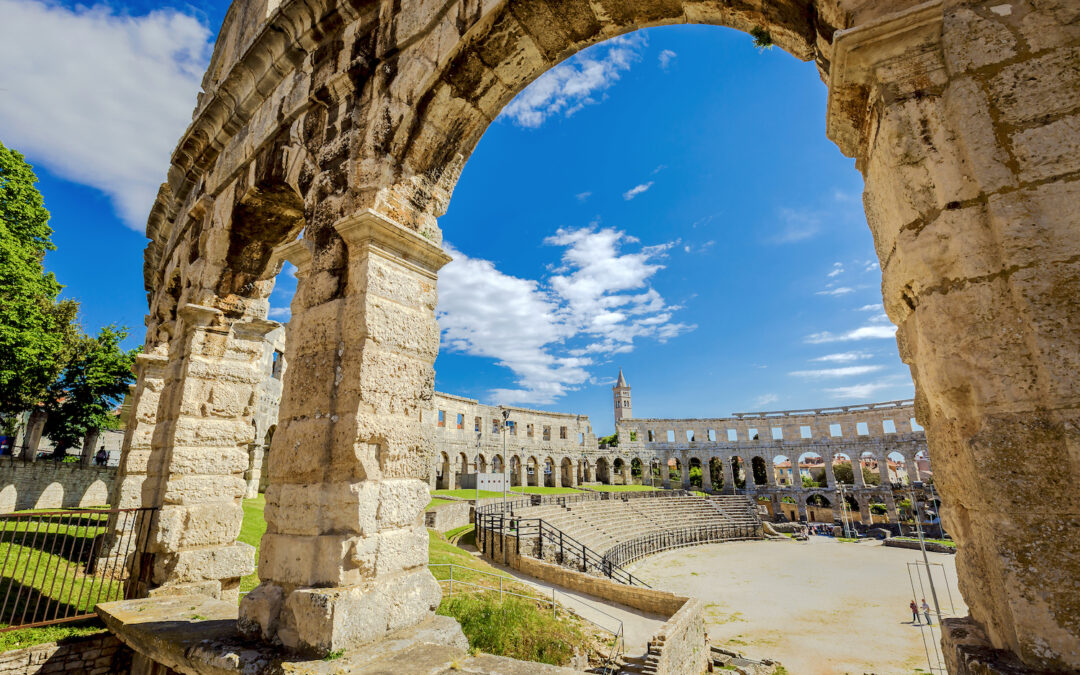
by Nada Cory | Jun 30, 2020 | Travel Croatia
Pula, capital of Istria, the country’s most northern peninsular, is close to the Italian border. It is a lush green expanse, whose close proximity to Italy can be felt in its culture and architecture. Settled in the prehistoric era and valued for its strategic location, Pula has been occupied, destroyed and rebuilt numerous times. The Romans, Ostrogoths and Venetians, as well as the Allied Forces in World War II, have each administered the city.
In addition, Pula is Istria’s largest metropolis, situated in the valley of seven hills, with extraordinary Adriatic views. It’s a knockout to walk around: narrow cobbled streets that end suddenly, with magnificent Roman buildings – including, notably, an enormous, spectacular amphitheater, built to host 20,000 spectators between 27 – 68 AD, and the only remaining Roman amphitheater in the world with a complete circle wall.
Istria is a wine region, so cloister yourself in one of the town’s tavernas and try the local grapes. The cuisine is a mixture of seafood and Italian dishes, with restaurants on the Limski canal, serving the best fresh mussels, and the region, famous for its highest quality of white truffles; Pula truffles are said to rival the Alba and Piedmont in neighboring Italy. Truffles were appreciated by the Romans; they were believed to have grown as the result of the God Jupiter throwing a bolt of lightning into an oak tree.
“Croatia and Beyond” travelers, are sure to enjoy a gastronomic experience during our time in Pula; what better way to understand and savor the local cuisine. In the center of the peninsula, there is the Mirna Valley, which is dotted with vineyards happy for you to try their Merlot, Teran, Pinots or Sauvignon Blanc – some excited oenophiles are calling it the “New Tuscany”, maybe a stop on our day of adventure.
Beaches are unspoiled – unlike the busier southern parts of the country, and the seas are known for being calm and tranquil, which means they’re perfect for swimmers and relaxation. The boat marinas are picture perfect, and being a working port, and a gateway to the Adriatic, it is very convenient to do some day tripping!
Pula is a must see stop on any Croatian itinerary, and seeing it through the eyes of your native Croatian Host Nada Cory, will add a special touch of hospitality and insight, to what is sure to be a memorable journey.
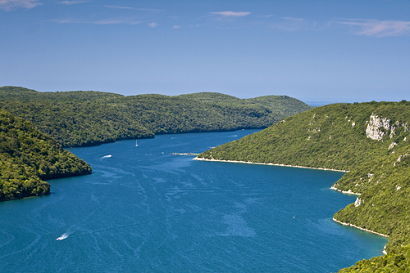
by Nada Cory | Jun 29, 2020 | Travel Croatia
On the western coast of Istria lies a stunningly beautiful natural phenomenon, the Lim Fjord. Technically, geologists would not categorize this as a fjord; to be accurate there would have to be some “glacial action” for a proper classification. However, in this region of Istria, it is known as the Lim Fjord or the Lim Canal. Whatever you wish to name it, add it to your must-see list when you visit Croatia!
If you happen to love rock climbing, or if you like to watch others climb rocks, the steep cliffs that line both sides of the fjord present a great challenge. For our nature lovers, you will note that the cliffs are heavily laden with pine trees dominating one side and deciduous trees on the other side, gorgeous any time of the year. The striking contrast of the green against with the blue water and grey limestone, is a picture-perfect scene.
Tranquil sports are allowed to transpire, such as swimming and kayaking, however, fishing, diving or fast motorboats are forbidden in this protected area. It is possible to hire a kayak and paddle off on a mini expedition to a secluded cave where you can enjoy a fish picnic with a glass of wine. There are other excursions available on boats, so you will be sure not to miss this scenic ride in its entirety, and enjoy a wonderful lunch, “with a view”.
“Croatia and Beyond” will be including the fjords outing as part of our pre-trip experience. Sign up today and reserve your place with “your host Nada Cory” for 2021. Nada is a Croatian native, residing in the US. You will be surprised as to the number of people who will welcome Nada and her group, with that extra attention and personal touch you would like to experience on a small intimate journey. Isn’t that what friends do?
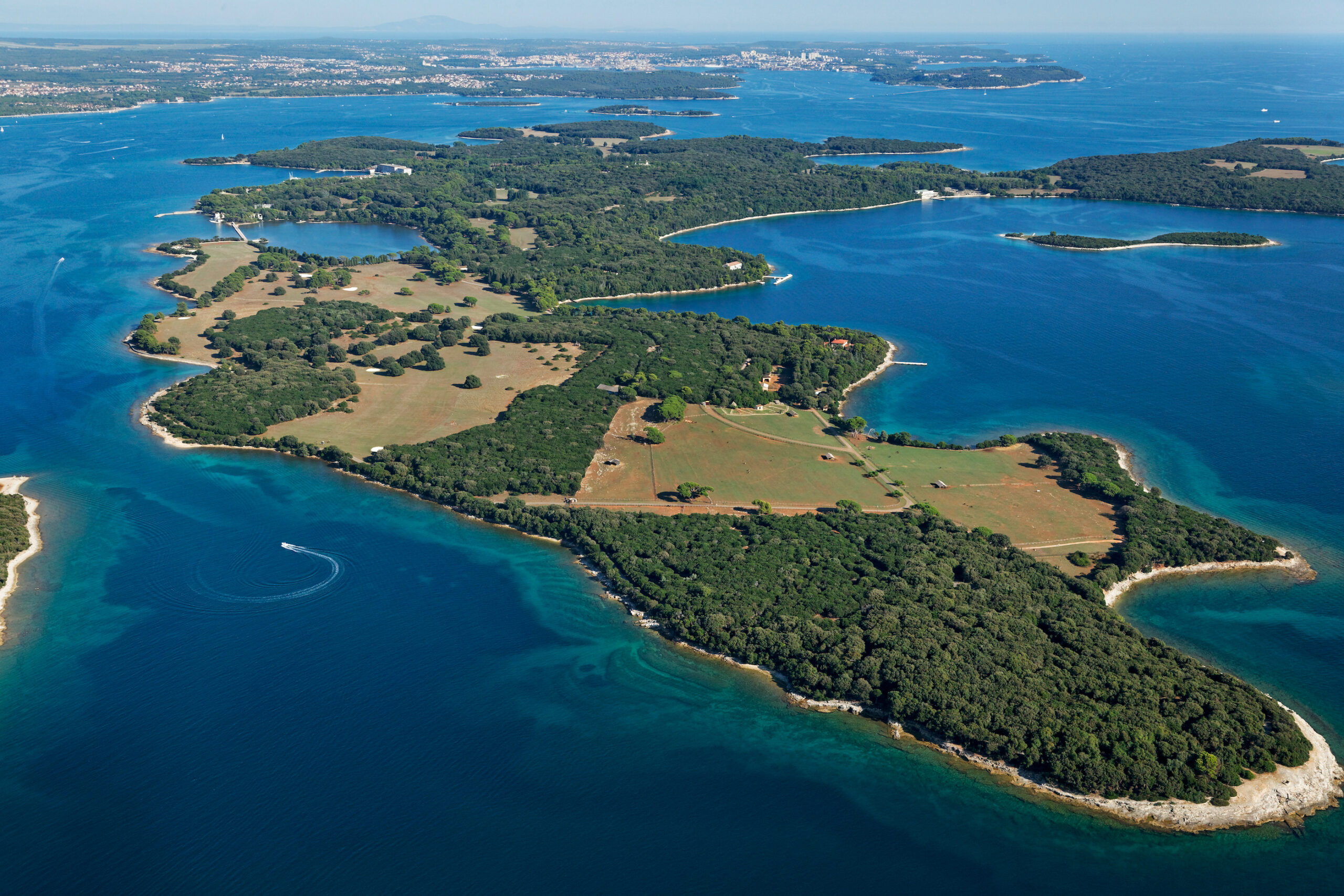
by Nada Cory | Jun 29, 2020 | Travel Croatia
The Brijuni Islands are an archipelago group of fourteen small islands in the Croatian part of the northern Adriatic Sea. Separated from the west coast of the Istrian peninsula by the narrow Fažana Strait, lies the largest island, Veliki Brijuni, 2 kilometers off the coast.
Like most islands of the Brijuni archipelago, Veliki Brijuni has been settled since prehistoric times, with the earliest traces going back to 3000 BC (early Bronze Age). The Illyrians lived on the islands from around 1500 BC until Roman conquest in 177 BC, and their remnants of five Illyrian fortified hill forts were discovered here.
The most important Roman site on the island is at Verige Bay, where the ruins of a 1st century villa rustica, a luxurious summer residence, can still be seen. After the fall of the Roman Empire in 476, the whole area came under Ostrogoth control, and during the Gothic War in the 6th century the islands were taken over by the Byzantine Empire. In 1331 the Republic of Venice and its aristocratic families ruled the Island.
Veliki Brijuni has certainly carved out a place in history. It is a known fact that after World War II, the island was turned into Josip Broz Tito‘s luxurious summer residence. Tito used the island from June 1947 to August 1979 for entertaining a great number of foreign ministers, dignitaries and heads of state. Since 1984 a permanent exhibition titled Josip Broz Tito at the Brijuni is housed on the island, where visitors can see a gallery of pictures documenting famous visitors and heads of state from 60 different countries, entertained on the Island. Other notable guests who visited during that period include Gamal Abdel Nasser, Jawaharlal Nehru, Eleanor Roosevelt, actress Sophia Loren and the novelist James Joyce.
In 1978 a safari park was created on the northern part of the island, covering an area of 9 hectares. The park is used as home to a number of exotic animals, most of which were brought to Tito as gifts. These include Nilgai antelopes (given by Jawaharlal Nehru in 1959), the Kob antelope, Somali sheep , zebras, Indian Elephants and llamas.
To add another measure of scientific history, rare Dinosaur footprints were unearthed at the National Park in Veliki Brijuni. To illustrate the size of these Mesozoic creatures who left their traces upon the land, a full-scale reconstruction was fashioned by a scientists and artists, with great accuracy. When sailing into the port of Veliki Brijuni and leaving the boat, it is possible to see the three-toed print in the limestone block, probably left by large theropod carnivores!
For those of you who travel with host Nada Cory on any of the “Croatia and Beyond” excursions, expect a visit to amazing Veliki Brijuni, as we journey from the mainland by boat for a memorable day. Adventure, cool breezes, time for a lovely meal, and wonderous sights to behold, awaits us for the day!





